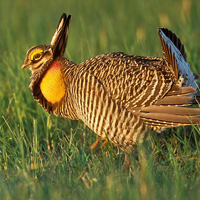Greater Prairie-Chicken
Scientific name: Tympanuchus cupido pinnatus

Cover photo credit: Brian E. Small
Status
Extirpated
"Extirpated" means the species lives somewhere in the world, and at one time lived in the wild in Ontario, but no longer lives in the wild in Ontario.
Date added to the Species at Risk in Ontario List
The Greater Prairie-Chicken was already listed as extirpated when the Endangered Species Act, 2007 took effect in 2008.
Read the most recent assessment report [PDF].
What it looks like
The Greater Prairie-Chicken is a large grouse once common on the tallgrass prairies of central North America. It is brown with light and dark barring and has a short rounded tail. During breeding, the male struts about in an elaborate courtship dance in which it erects its wing, neck and tail feathers and releases air from orange air sacs on its neck to produce a loud booming sound. The male also has conspicuous yellow eye combs.
Where it lives
The Greater Prairie-Chicken’s original habitat was the tallgrass prairies of midwestern North America. To support a flock, this bird requires large areas of undisturbed grasslands, with few shrubs or trees for nesting and dense grass stands and brush cover for overwintering.
Where it’s been found in Ontario
The Greater Prairie-Chicken was first found on southwestern Ontario prairies in the early 1800s. By the end of the 19th century, its range had expanded to the east and north, as far as Lake Simcoe. With much of the land cleared for agriculture by 1900, the range subsequently contracted and the population completely disappeared from southern Ontario in the 1920s. Meanwhile, it had spread to the Sault Ste Marie area, Manitoulin Island and northwestern Ontario in the early 1900s from the United States. These populations also increased and then declined. By the 1960s it was gone from the northwest, and from the Sault Ste Marie area and Manitoulin Island in the 1970s.
The Greater Prairie-Chicken is no longer found in Canada. In the United States, their range extends from North Dakota, Minnesota and Wisconsin, south to Kansas, Oklahoma and Missouri, west to Colorado and east to Wisconsin and Illinois. The core of the population is in parts of Kansas, Nebraska, and South Dakota.
Why it disappeared from Ontario
The cultivation of native prairie was initially a benefit to the Greater Prairie-Chicken but then became the major threat to its survival. The first settler’s grain crops supplied high energy food for the birds and their populations flourished. Then as prairie land was increasingly converted to farming, the habitat of Greater Prairie-Chicken was restricted to smaller and smaller areas. In Ontario, interbreeding with other species of grouse eliminated the Greater Prairie-Chicken in the Manitoulin Island area.
Action we are taking
Greater Prairie-Chicken receives species protection under the Endangered Species Act, 2007.
All species listed on the Species at Risk in Ontario List may be eligible for consideration for government funding through the Species at Risk Stewardship Program.
What you can do
Report a sighting
Submit your observations of species at risk to the Natural Heritage Information Centre (NHIC), which is Ontario’s conservation data centre. "Join the (NHIC) Rare Species of Ontario" project in iNaturalist to make submitting your observations quick and easy.
Volunteer
Volunteer with species at risk programs, such as community science surveys, through your local nature club, a provincial park or other conservation organizations.
Be a good steward
Private landowners have a very important role to play in species recovery. If you find species at risk on your land, you may be eligible for stewardship programs that support the protection and recovery of species at risk and their habitats. Learn more about the Species at Risk Stewardship Program.
Birds Canada is working to advance the understanding, appreciation and conservation of wild birds and their habitat in Ontario and elsewhere. For more information on how you can help, visit the Bird’s Canada website.
Report illegal activity
Report any illegal activity related to species at risk to
Quick facts
- The Greater Prairie-Chicken once numbered in the millions in Alberta, Saskatchewan, Manitoba, and Ontario, but disappeared from most of its Canadian range by the mid-20th century.
- New genetic evidence indicates that the Greater Prairie-Chicken was a native species in Canada for the past 9,000 years and did not colonize the prairies habitat with European settlement as previously thought.
- Each flock of Greater Prairie-Chicken requires at least 5,000 to 6,000 hectares of suitable grassland habitat to provide ample cover and food.